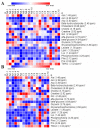A Pilot Study on Biochemical Profile of Follicular Fluid in Breast Cancer Patients
- PMID: 36984881
- PMCID: PMC10054828
- DOI: 10.3390/metabo13030441
A Pilot Study on Biochemical Profile of Follicular Fluid in Breast Cancer Patients
Abstract
Breast cancer (BC) is the most common type of cancer among women in almost all countries worldwide and is one of the oncological pathologies for which is indicated fertility preservation, a type of procedure used to help keep a person's ability to have children. Follicular fluid (FF) is a major component of oocyte microenvironment, which is involved in oocyte growth, follicular maturation, and in communication between germ and somatic cells; furthermore, it accumulates all metabolites during oocytes growth. To obtain information about changes on fertility due to cancer, we aimed at investigating potential biomarkers to discriminate between FF samples obtained from 16 BC patients and 10 healthy women undergoing in vitro fertilization treatments. An NMR-based metabolomics approach was performed to investigate the FF metabolic profiles; ELISA and western blotting assays were used to investigate protein markers of oxidative and inflammatory stress, which are processes closely related to cancer. Our results seem to suggest that FFs of BC women display some significant metabolic alterations in comparison to healthy controls, and these variations are also related with tumor staging.
Keywords: NMR-based metabolomics; breast cancer; fertility preservation; inflammation; oxidative stress; tumor stage.
Conflict of interest statement
The authors declare no conflict of interest.
Figures





References
-
- The Cancer Atlas. [(accessed on 13 March 2023)]. Available online: https://canceratlas.cancer.org/the-burden/breast-cancer/
-
- GLOBOCAN 2020: New Global Cancer Data. [(accessed on 13 October 2022)]. Available online: https://www.uicc.org/news/globocan-2020-new-global-cancer-data.
LinkOut - more resources
Full Text Sources

